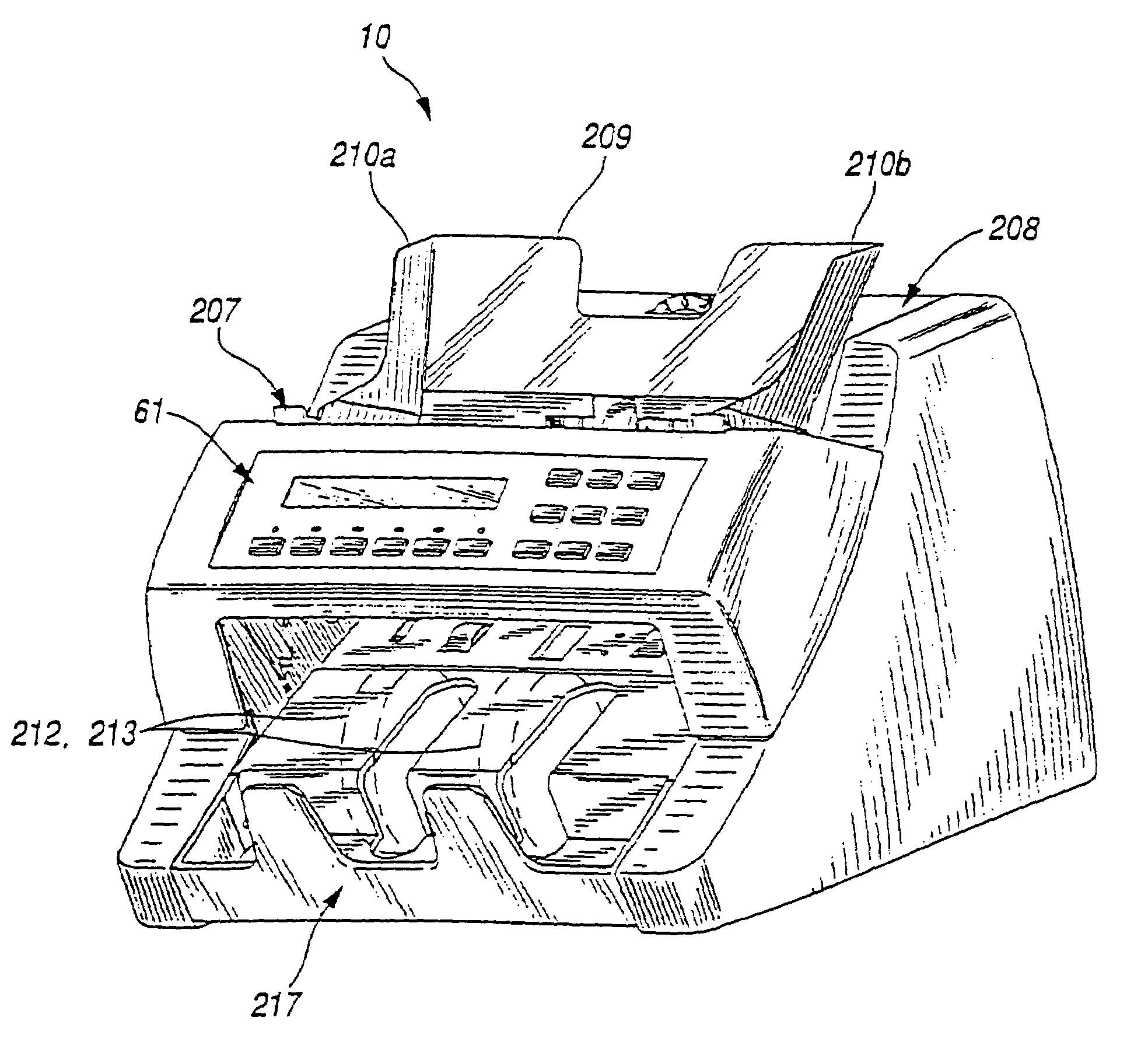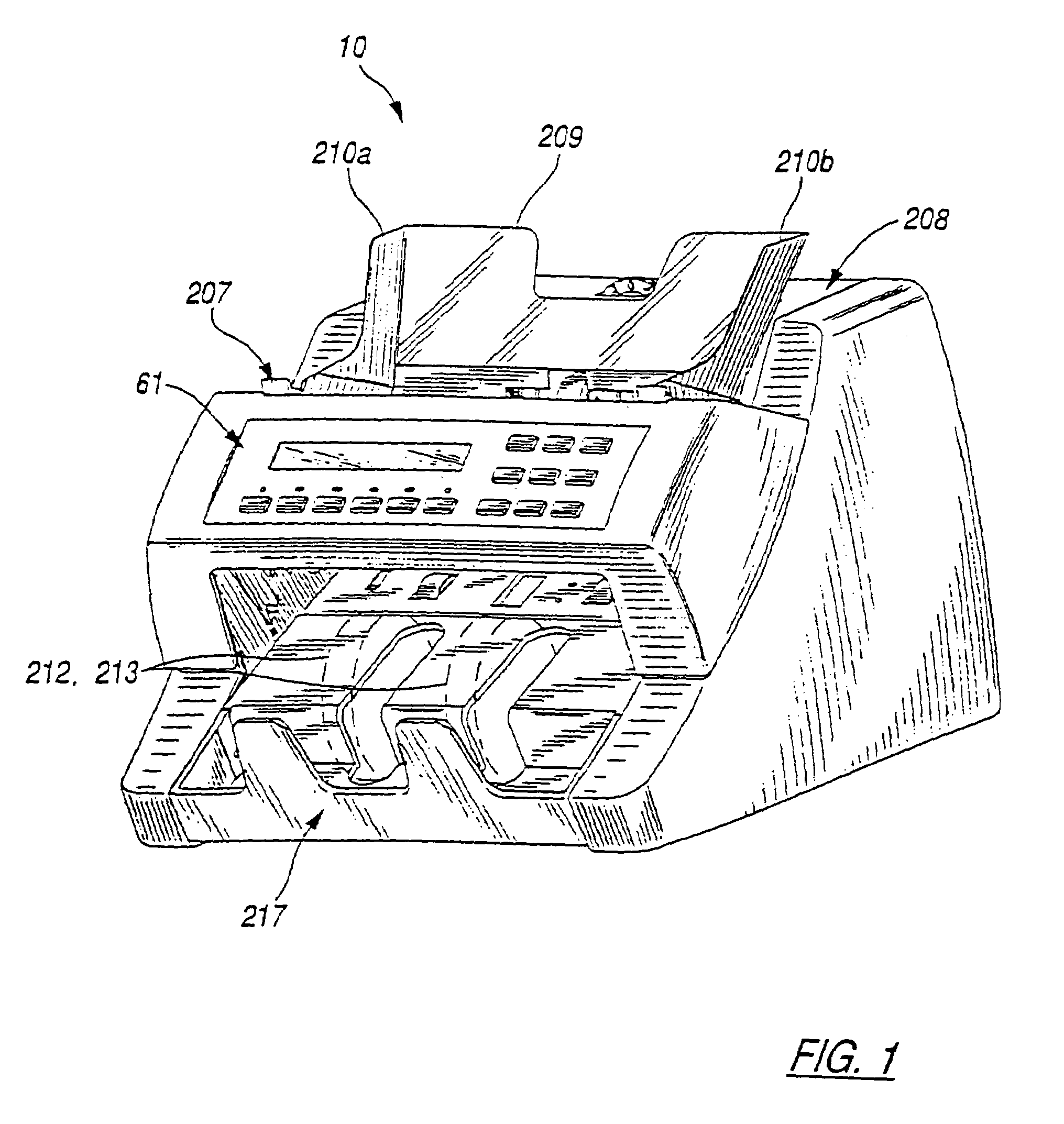Machines that are currently available for simultaneous scanning and counting of documents such as paper currency are relatively complex and costly, and relatively large in size.
The complexity of such machines can also lead to excessive service and maintenance requirements.
These drawbacks have inhibited more widespread use of such machines, particularly in banks and other financial institutions where space is limited in areas where the machines are most needed, such as teller areas.
The above drawbacks are particularly difficult to overcome in machines which offer much-needed features such as the ability to scan bills regardless of their orientation relative to the
machine or to each other, and the ability to authenticate genuineness and / or denomination of the bills.
A major obstacle in implementing automated currency discrimination systems is obtaining an optimum compromise between the criteria used to adequately define the characteristic pattern for a particular currency denomination, the time required to analyze
test data and compare it to predefined parameters in order to identify the currency bill under scrutiny, and the rate at which successive currency bills may be mechanically fed through and scanned.
Even with the use of microprocessors for
processing the
test data resulting from the scanning of a bill, a finite amount of time is required for acquiring samples and for the process of comparing the
test data to stored parameters to identify the denomination of the bill.
However, these systems do not efficiently utilize the information which is obtained.
As a result, the time required to make these comparisons is increased which in turn can reduce the
operating speed of the entire scanning
system.
Likewise, it has been found that bills which have experienced a high degree of usage may shrink, resulting in a reduction of the dimensions of such bills.
Such shrinkage may likewise result in variations in scanning patterns.
As a result, if, for example, a $20 master pattern is generated by scanning a crisp, genuine $20 bill, the discrimination
system may reject an unacceptable number of genuine but worn $20 bills.
Likewise, if a $20 master pattern is generated using a very worn, genuine $20 bill, the discrimination
system may reject an unacceptable number of genuine but crisp $20 bills.
As a result of the wide variety of currencies used throughout the world, a discrimination system designed to
handle bills of one country generally can not
handle bills from another country.
Likewise, the method of discriminating bills of different denominations of one country may not be appropriate for use in discriminating bills of different denominations of another country.
For example, scanning for a given characteristic pattern along a certain portion of bills of one country, such as
optical reflectance about the central portion of U.S. bills, may not provide optimal discrimination properties for bills of another country, such as German marks.
A drawback of the foregoing technique for scanning both surfaces of a currency bill is that it is time-consuming to process and compare both sets of data samples for the scanned bill to the stored characteristic patterns.
Another drawback of the foregoing scanning technique is that the set of data samples corresponding to the black surface of the scanned bill occasionally leads to false positive identification of a scanned bill.
However, the ability of a system to line up scanned and master patterns is often hampered by the improper
initiation of the scanning process which results in the generation of scanned patterns.
If the generation of scanned patterns is initiated too early or too late, the resulting pattern will not correlate well with the master pattern associated with the identity of the currency; and as a result, a genuine bill may be rejected.
For example, a
discriminator that discriminates bills based on patterns of
transmitted light may be able to identify the denomination of a forward fed bill regardless of whether the bill is fed face up or face down, but the same
discriminator would not be able to discriminate between a bill fed face up and a bill fed face down.
Furthermore, for a number of reasons, a discriminating unit may be unable to determine the denomination of a bill.
These reasons include a bill being excessively soiled, worn, or faded, a bill being torn or folded, a bill being oriented in a manner that the discriminating unit cannot
handle, and the discriminating unit having poor discriminating performance.
Furthermore, the discriminating unit and / or a separate authenticating unit may determine that a bill is not genuine.
While this is desirable with respect to bills which are positively identified as being fake, it may be undesirable with respect to bills which were not identified for other reasons even though they are genuine bills.
Such a procedure can be inefficient in some situations.
Also, if a bill was rejected the first time because it was, for example, excessively soiled or too worn, then it is likely that the bill will remain unidentified by the discriminating unit even if re-fed.
A problem with the above described situations where the totals and / or counts do not reflect all the genuine bills in a stack is that an operator must then count all the unidentified genuine bills by hand and add such bills to separately generated totals.
As a result the chance for
human error increases and operating efficiency decreases.
An error could result from the teller miscounting the unidentified bills, the teller forgetting to add the two totals together, or the teller overlooking the unidentified bills entirely and only recording a deposit of $730.
Moreover, even if the teller makes no mistakes, the efficiency of the teller is reduced by having to manually calculate additional totals.
In general, it has been found that no single
authentication test is capable of detecting all types of counterfeit documents while at the same time not rejecting any genuine documents.
However, it has been found that the presently known
ultraviolet authentication methods do not detect all types of counterfeits.
 Login to View More
Login to View More  Login to View More
Login to View More 


